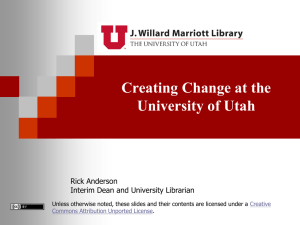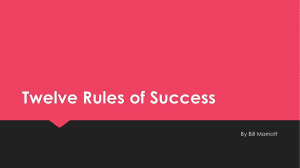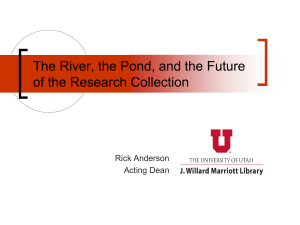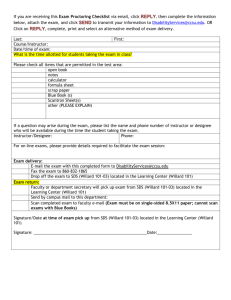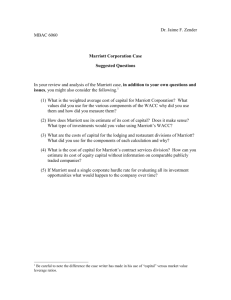UsingPatentsInResearch
advertisement
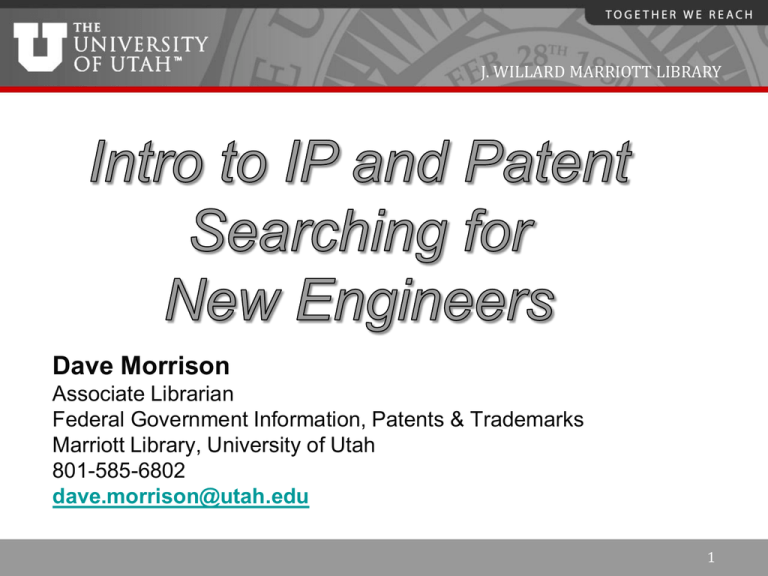
J. WILLARD MARRIOTT LIBRARY Dave Morrison Associate Librarian Federal Government Information, Patents & Trademarks Marriott Library, University of Utah 801-585-6802 dave.morrison@utah.edu 1 J. WILLARD MARRIOTT LIBRARY What is Intellectual Property (IP)?! Property rights for intellectual creations that have been put into fixed, tangible format 2 J. WILLARD MARRIOTT LIBRARY Four types of intellectual property • Patents – protects new inventions • Trademarks – anything that identifies the source of a product or service offered in commerce • Copyrights – protect the specific expression of an idea in text, music, choreography, graphic arts • Trade Secrets – any secret formula, process, or business method that offers a commercial advantage to the holder 3 J. WILLARD MARRIOTT LIBRARY PATENTS 4 J. WILLARD MARRIOTT LIBRARY What is a patent? A Patent is a property right granted by the United States to the original inventor(s) for a limited time in exchange for public disclosure of the invention. The Patent gives the inventor the [negative] right “to exclude others from making, using, offering for sale, or selling” the invention in the United States, or importing the invention into the United States. Article I, Section 8, Clause 8 of the United States Constitution, known as the ‘Copyright Clause’ 5 J. WILLARD MARRIOTT LIBRARY Three types of patents • Utility Patents – Granted for a process; machine or manufacture; composition of matter; or an improvement thereof. Utility patents have sequential numbers. • Design Patents – Protects the new, ornamental design (i.e. “outward appearance”) for an article of manufacture. Design patent numbers are preceded by the letter “D.” • Plant Patents – granted on any distinct and new variety of an asexually reproduced plant. Plant patent numbers are preceded by “PP.” 6 J. WILLARD MARRIOTT LIBRARY How long do they last? • Utility patent – twenty years from the nonprovisional patent filing date • Design patent – fourteen years from issue date • Plant patent – twenty years from filing date Once these terms expire, the invention is now ‘public domain,’ and may be made, used or sold by anyone without licensing! 7 J. WILLARD MARRIOTT LIBRARY Trademarks ® 8 J. WILLARD MARRIOTT LIBRARY Trademarks • Any word, phrase, symbol, logo, color, sound, or scent used to: – Distinguish product or service from others in the marketplace – Identify the source of commercial origin – Certify quality, standards, or geographic origin • A service mark is the same as a trademark except that it identifies and distinguishes the source of a service rather than a product. Federal trademarks once registered remain in effect for ten years, and may be renewed indefinitely once they expire! J. WILLARD MARRIOTT LIBRARY Obtaining Trademark Rights Three sources: • Common-law use of the mark in commerce without registration; or • Registration with the Utah (or other) State Dept. of Commerce as a state trademark; or • Federal registration of a mark in actual use or with an ‘intent to use’ with the U.S. Patent and Trademark Office. 10 J. WILLARD MARRIOTT LIBRARY Trademark Symbols • • ™ and SM (either superscript or subscript) – The letters SM may be used in place of TM to indicate a service mark. – These two symbols indicate the owner considers this to be their common-law (i.e., unregistered) trademark. – May also be used with State-registered trademarks ® – This symbol indicates that the mark has been registered with the USPTO, and may only be used when such registration has been granted. 11 J. WILLARD MARRIOTT LIBRARY Trademarks may become generic Trademark rights may be lost if the trademark becomes the common term for the product, even when produced by other companies, e.g. – – – – – Aspirin Raisin Bran Kerosene Thermos Elevator, escalator So, be careful when using the words ‘Kleenex’ and ‘Xerox!’ 12 J. WILLARD MARRIOTT LIBRARY State & Common Law Marks There’s no legal requirement to search state or common law marks in order to apply for a federal trademark registration. However, doing so may save you time, and MONEY! 13 J. WILLARD MARRIOTT LIBRARY Why Apply for a Federal Trademark? • constructive notice to the public of claim of ownership; • legal presumption of the registrant's ownership of the mark and exclusive right to use the mark nationwide on or in connection with the goods and/or services listed in the registration; • use of the U.S registration as a basis to obtain registration in foreign countries; ability to bring an action concerning the mark in federal court; ability to file the U.S. registration with the U.S. Customs Service to prevent importation of infringing foreign goods. http://www.uspto.gov/trademarks/basics/register.jsp J. WILLARD MARRIOTT LIBRARY Searching Utah State Trademarks Utah State Trademarks may be searched at: https://secure.utah.gov/trademark/search/index.html and Business Names at: https://secure.utah.gov/bes/ Business services are also available in person at: Department of Commerce Division of Corporations and Commercial Code 160 East 300 South, P.O. Box 45802 Salt Lake City, Utah 84145-0802 (801) 530-4849 J. WILLARD MARRIOTT LIBRARY Copyright © 20 J. WILLARD MARRIOTT LIBRARY What is copyright? • A form of protection provided to the creators of “original works of authorship.” • Includes literary, dramatic, musical, artistic, and certain other intellectual works, both published and unpublished. • Registered by the U.S. Copyright Office at the Library of Congress. • Current registration fee – $65.00 for paper filing, $35.00 for online filing • Copyright term – your lifetime plus 70 years. 21 J. WILLARD MARRIOTT LIBRARY What kinds of work are protected under copyright? • Literary works • Serials/Periodicals • Musical and Dramatic works, with accompanying words or music • Sound and video recordings • Pictorial, Graphic and Sculptural works • Architectural works • Computer software • Mask works fixed in semiconductor chips http://www.copyright.gov/circs/circ01.pdf 22 J. WILLARD MARRIOTT LIBRARY What kinds of work are not protected? • Works not fixed in a tangible form of expression • Titles, names, slogans, short phrases, familiar designs or symbols, mere variations of typographic ornamentation, lettering, or coloring, mere listings of contents or ingredients • Ideas, procedures, methods, systems, processes, concepts, principles, discoveries, or devices, as distinguished from a description, explanation, or illustration. • Works consisting entirely of common property information and containing no original authorship. 23 J. WILLARD MARRIOTT LIBRARY Rights Under Copyright Law Section 106 of the 1976 Copyright Act gives the owner of copyright, and others authorized by the owner, certain exclusive rights, including the right: – To reproduce the work – To prepare derivative works – To distribute copies or phonorecords of the work through transfer of ownership such as through sale, or lease – To display the work publicly – To publicly perform the work by means of a digital audio transmission ( for sound recordings) – To authorize others to do all of the above http://www.copyright.gov/title17/index.html, Title 17, “Copyright.” 24 J. WILLARD MARRIOTT LIBRARY Some Limitations Under Copyright Law • Copyright covers the particular expression of an idea, not the idea itself! • Rights are not unlimited – sections 107122 of the Copyright Law of the United States of America, Chapter 1, establish limitations: – http://www.copyright.gov/title17/92chap1.html. 25 J. WILLARD MARRIOTT LIBRARY Additional Limitations Under ‘Fair Use’ • Not mentioned in older copyright law; developed through court decisions over the years • Currently covered in section 107 of the present copyright law (17 USC 107) http://www.copyright.gov/title17/92chap1.html#107 • Covers purposes for which reproduction of a copyrighted work may be considered “fair”, and four factors used to determine the fairness of a particular use. 26 J. WILLARD MARRIOTT LIBRARY Four Factors That Help Determine ‘Fair Use’ • What is the nature of the copyrighted work? • How much of the work is used and how substantial a portion of the whole work? • What is the purpose and character of the use? Commercial? Nonprofit educational use? • What effect does the use have on the potential market for or value of the copyrighted work? 27 J. WILLARD MARRIOTT LIBRARY Purposes For Which Reproduction of a Copyrighted Work Might Be Considered ‘Fair Use’ • Criticism • Comment • Parody • • • • News reporting Teaching Scholarship Research 28 J. WILLARD MARRIOTT LIBRARY How is Copyright Secured Under Current U.S. Copyright Law? • Automatic granted under the Berne Convention of 1989 from the time the work is created in fixed form, whether published or unpublished; • Registration not required, but confers definite advantages when dealing with enforcement issues and compensation for infringement; • Unpublished foreign works are also eligible for copyright protection in the U.S., but there are eligibility restrictions for published foreign works. 29 J. WILLARD MARRIOTT LIBRARY Benefits of Copyright Registration • Registration establishes a public record for the claim of copyright; • For works of U.S. origin, registration is required before an infringement suit may be filed in Federal court (!); • Registration enables the copyright owner to record the registration with the U.S. Customs Service for protection against the importation of infringing copies! 30 J. WILLARD MARRIOTT LIBRARY Forms of Copyright Notice • Notice of Copyright is no longer required under the Berne Convention, but may still be used, and is recommended. • Notice has three elements: – The symbol or the word “Copyright” or the abbreviation “Copr.” ( Use a “P” rather than a “C” in the circle for sound recordings) – Year of first publication – Name of owner of copyright 31 J. WILLARD MARRIOTT LIBRARY When Does A Copyrighted Work Enter The Public Domain? • Works copyrighted before 1923 are now in the public domain. • Works copyrighted on or after 1/1/1923 may still be under copyright protection, but determining copyright is not a simple question; see http://copyright.cornell.edu/resources/publicdomain.cfm • The U.S. Copyright Office will do a search to determine current copyright status on a particular work upon request, for an hourly fee. 32 J. WILLARD MARRIOTT LIBRARY Trade Secrets ? 33 J. WILLARD MARRIOTT LIBRARY Trade Secrets • Information not generally known to others that is capable of yielding a business advantage over competitors who do not know it. • May be: – – – – – – – Formulas Patterns Processes Devices Compounds Data, mailing lists, etc. Other compilation of information that is used in business. 34 J. WILLARD MARRIOTT LIBRARY Examples of Trade Secrets • The formula for Coca-Cola is the world’s most famous trade secret, but check out what the Wikipedia says here . • Colonel Sanders’ secret recipe for fried chicken, served at KFC. Sanders also received U.S. patent 3,245,800 for a method of pressure-cooking fried chicken. • The formula for WD-40. 35 J. WILLARD MARRIOTT LIBRARY Benefits of Trade Secrets • • • • • No Fees No need to disclose details to the public Can be established without naming inventors No term limits Rights obtained immediately 36 J. WILLARD MARRIOTT LIBRARY Drawbacks of Trade Secrets • Must be able to keep it a secret! • May be independently discovered by legitimate or illegitimate means, thus, no longer a secret. • May be more difficult to enforce rights and prosecute lawsuits involving a trade secret, as the existence of the trade secret must be proven before a lawsuit may proceed. 37 J. WILLARD MARRIOTT LIBRARY 38 J. WILLARD MARRIOTT LIBRARY Let’s begin with specific references to a new technology in an Internet news article from 2008 – here we have the inventors’ names, and their research affiliations. 39 Let’s start our search here! No. 5 is the 2008 patent application from the news article, and no. 1 might be a continuation – reflecting four more years of developments – of the same invention. Full images of every page of the granted patent or published application in PDF format. INID codes Gathers all pages of the document into a single PDF file. (52) U.S. Cl… 257/415, 438/53, 174/254, etc. To examine the classifications, start by clicking the ‘Home’ button.. CPC is the new Cooperative Patent Classification System, which the USPTO will adopt over the next 3-5 years. Class 174, subclass 254, which we got from the ‘US Cl.’ field on the face of the patent. ‘Contracting’ all the main lines, except for the one showing subclass 254.. Mainline One-dot indention Two-dot indention Click on the line to check the hierarchy of the subclass, and then the ‘Descriptions’ for each level of the hierarchy. 53 J. WILLARD MARRIOTT LIBRARY 54 J. WILLARD MARRIOTT LIBRARY Full definition for Class 174 subclass 254. Note the ‘search note’ indicating another class that might contain similar inventions! 55 J. WILLARD MARRIOTT LIBRARY 56 All Granted Patents since 1790 that have a classification in 174/254 (the oldest was granted in 1926!). Feb 2010 – 992 patents; Feb 2011 – 1059 patents; Feb 2012 – 1140 patents; Aug 2013 – 1306 patents! Note the increasing rate of change! If we go back and click on the blue ‘A’ in the Classification Schedule, we get a list of all applications published since 2001 that have a classification in 174/254. 58 All published applications from 2001 to the present that have a classification in 174/254. Some of these published applications will also show up as Granted Patents, but the text will most likely be different from the application. Feb 2008 – 151 Feb 2010 – 301 (two year interval) Feb 2011 – 413 Feb 2012 – 532 Aug 2013 – 663! Once again, note the positive rate of change! We may search any one of 30 specific fields on the ‘Quick Search’ or ‘Boolean’ search screens in either the PatFT or AppFT databases. Note that the ‘Field’ name must be changed to ‘Current US Classification’ to use a Classification number as the search term. Here’s an example of searching for an exact keyword phrase in the Applications database. Note the dollar sign ($) used as a ‘wild card,’ and the quotation marks to search for that exact phrase as a whole, not the words individually. Too many applications to look through! How can we reduce the number of applications we must examine? Remember, we only need a few examples of similar inventions, which will then lead us to the appropriate classifications! We may restrict the number of ‘hits’for our keyword phrase by limiting the phrase to only the ‘Title’ OR ‘Abstract’ fields on the front page of each application! Much better results! J. WILLARD MARRIOTT LIBRARY How can we find out about the research strengths of a particular business or research institution? Such as, in the case of our current example, Northwestern University?! 65 J. WILLARD MARRIOTT LIBRARY Here, we change the ‘Field’ name to ‘Assignee Name,’ that is, the entity that owns the rights to the patent. J. WILLARD MARRIOTT LIBRARY New patent applications reflect many of Northwestern University’s strongest research areas. When we search with the name of a particular company, the results may provide ‘competitive intelligence’ about that company’s research interests. J. WILLARD MARRIOTT LIBRARY Our search results may be more easily visualized and used in spreadsheet format. We can easily do this using the tools available at the website www.freepatentsonline.com with a free subscription. J. WILLARD MARRIOTT LIBRARY J. WILLARD MARRIOTT LIBRARY J. WILLARD MARRIOTT LIBRARY J. WILLARD MARRIOTT LIBRARY J. WILLARD MARRIOTT LIBRARY Column G, the names of the owners of each patent, is an instant marketing tool for anyone with new, patented technology in this field. Or, as an employment tool for identifying which companies might be interested in hiring new researchers with experience in these fields! J. WILLARD MARRIOTT LIBRARY Innovation – how technology changes over time We can trace the development of a given technology over time by looking at the ‘prior art’ and ‘cited by’ links on the front page of U.S. patents. J. WILLARD MARRIOTT LIBRARY Let’s select an older patent from the ‘Patent Number’ search screen so we can look at one that has had time to influence later (that is, more recent) inventions. J. WILLARD MARRIOTT LIBRARY Definitely ‘an older invention!’ J. WILLARD MARRIOTT LIBRARY Later patents that refer back to this 1998 patent as part of their ‘prior art.’ Prior Art – or earlier inventions that show earlier steps in the development of this technology. J. WILLARD MARRIOTT LIBRARY These thirteen more recent patents all refer back to US5759417 as part of the ‘Prior Art,’ or earlier line of development, for their invention. • European Patent Office – http://worldwide.espacenet.com • Coverage: – EPO and PCT published applications from the most recent 24 months. – In January 2012, esp@cenet® held data on 70 million patents from 90 countries. Most include an English-language abstract. Coverage from 1836 (US) forward (varies by country). – JPO published abstracts in English from October 1976 forward. – Updated weekly. http://worldwide.espacenet.com/ J. WILLARD MARRIOTT LIBRARY J. WILLARD MARRIOTT LIBRARY ‘Search’ button further down at bottom of screen. Published U.S. application number for our original ‘stretchable electronics’ patent application. J. WILLARD MARRIOTT LIBRARY J. WILLARD MARRIOTT LIBRARY 21 Languages including English! J. WILLARD MARRIOTT LIBRARY J. WILLARD MARRIOTT LIBRARY J. WILLARD MARRIOTT LIBRARY J. WILLARD MARRIOTT LIBRARY Link to patent family at Esp@cenet http://worldwide.espacenet.com/publicationDeta ils/inpadocPatentFamily?page=0&FT=D&CC=US &locale=en_EP&DB=EPODOC&NR=2008157235 A1&date=20080703&ND=3&KC=A1 J. WILLARD MARRIOTT LIBRARY J. WILLARD MARRIOTT LIBRARY J. WILLARD MARRIOTT LIBRARY J. WILLARD MARRIOTT LIBRARY J. WILLARD MARRIOTT LIBRARY J. WILLARD MARRIOTT LIBRARY J. WILLARD MARRIOTT LIBRARY Live link from Esp@cenet. J. WILLARD MARRIOTT LIBRARY • USPTO Patents Main Page [ www.uspto.gov/main/patents.htm ] • USPTO Resources and Guidance [ http://uspto.gov/patents/resources/index.jsp ] • General Information Concerning Patents “The best introduction to patents and trademarks I’ve ever found! Originally about 87 pages in print, plus a handy list of FAQs.” [ http://www.uspto.gov/patents/resources/general_info_concerning_patents.jsp ] J. WILLARD MARRIOTT LIBRARY • Pro Se and Pro Bono “The page for those inventors either filing on their own behalf (pro se) or are seeking free or greatly reduced services from patent professionals.” [ http://www.uspto.gov/inventors/proseprobono/index.jsp ] • The Inventors Eye “The USPTO's bimonthly publication for the independent inventor community” [ http://www.uspto.gov/inventors/independent/eye/index.jsp ] • Trademark Information Network (TMIN) Videos [ http://www.uspto.gov/trademarks/process/TMIN.jsp ] J. WILLARD MARRIOTT LIBRARY Selected PTRCs (Patent and Trademark Resource Centers) on the Web • University of Utah http://campusguides.lib.utah.edu/content.php?pid=71473 • Georgia Tech (Atlanta) http://www.library.gatech.edu/research_help/subject/index.php?/patents • University of Maryland, College Park https://secure.utah.gov/trademark/index.html • University of Michigan (Ann Arbor) http://guides.lib.umich.edu/content.php?pid=35640 • Oklahoma State University (Stillwater) www.library.okstate.edu/patents/index.htm • University of Texas (Austin) http://www.lib.utexas.edu/engin/patent/index.html J. WILLARD MARRIOTT LIBRARY Selected Patent Search Tutorials Available On the Web • ‘Basic Patent Training for the Independent Inventor and Small Businesses’ (USPTO) – https://uspto.connectsolutions.com/certificationpackage/ • ‘Patent Searching’ video (Auburn PTRC) http://diglib.auburn.edu/tutorials/uspto6.htm • Preliminary Patent Searching on the Web (Stillwater PTRC) http://www.library.okstate.edu/patents/services.htm • University of Central Florida Patent Tutorial (Orlando PTRC) http://library.ucf.edu/GovDocs/PatentsTrademarks/default.asp • Patent Searching Using the Esp@cenet Patent Database http://www.european-patent-office.org/wbt/espacenet/ J. WILLARD MARRIOTT LIBRARY Selected International Patent Sites • Esp@cenet http://worldwide.espacenet.com/ • Japanese Patent Office www.jpo.go.jp Highly recommended! • European Patent Office www.european-patent-office.org/index.htm • World Intellectual Property Office (WIPO) www.wipo.org – WIPO Patentscope http://www.wipo.int/patentscope/search/en/search.jsf – Search WIPO’s Intellectual Property Digital Library http://ipdl.wipo.int/ J. WILLARD MARRIOTT LIBRARY Trademark Websites Search Federal trademarks at the USPTO Web Pages: http://www.uspto.gov/trademarks/index.jsp Apply for a Federal trademark online: http://www.uspto.gov/teas/e-TEAS/index.html Selected commercial trademark search services: http://compumark.thomson.com/jsp/index.jsp www.trademark.com 100 J. WILLARD MARRIOTT LIBRARY Other Selected Web Sites • U.S. Copyright Office ( www.copyright.gov/ ) – Especially see Circular 1, “Copyright Basics” • Lemelson-MIT’s Handbook for Inventors – http://web.mit.edu/invent/h-main.html • Intellectual Property Basics (U. of New Hampshire School of Law, formerly Franklin Pierce Law Center) – http://law.unh.edu/thomasfield/ipbasics/index.php • Google Patent Search – http://www.google.com/patents • Inventors Network – www.inventnet.com 101 J. WILLARD MARRIOTT LIBRARY Current Favorite Web Tools! • Esp@cenet http://worldwide.espacenet.com/ • freepatentsonline.com www.freepatentsonline.com My favorite non-USPTO website, along with the Esp@cenet database! Export U.S. patents and applications into .xls files for easier sorting and analysis. • Pat2PDF www.pat2pdf.org Free full-text U.S. Patent copies downloadable as PDF files; excellent for printing or sharing by email! J. WILLARD MARRIOTT LIBRARY For Further Information .. • USPTO Information Line 800-PTO-9199 • Dave Morrison, Marriott Library, University of Utah 801-585-6802 http://campusguides.lib.utah.edu/content.php?pid=71473 103 J. WILLARD MARRIOTT LIBRARY Questions?! 104 J. WILLARD MARRIOTT LIBRARY Thanks! 105 J. WILLARD MARRIOTT LIBRARY 106
